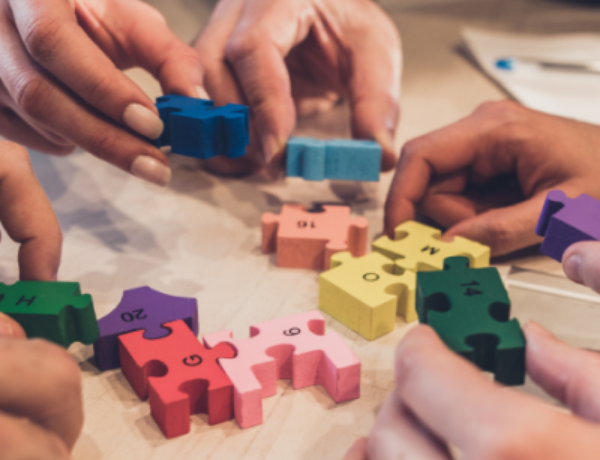Emotions, Feelings
and Moods:
What’s the Difference?
Emotions and feelings are often used interchangeably, but they really aren’t the same thing. So what is the difference between emotions and feelings and moods?
Let’s break down the difference and looking at proven ways to improve emotional literacy and emotional intelligence.
by Michael Miller
It’s Only a Matter of Time
The short answer is: Time. Emotions come first, then feelings come after as the emotion chemicals go to work in our bodies. Then moods develop from a combination of feelings.
Emotions are chemicals released in response to our interpretation of a specific trigger. It takes our brains about 1/4 second to identify the trigger, and about another 1/4 second to produce the chemicals. By the way, emotion chemicals are released throughout our bodies, not just in our brains, and they form a kind of feedback loop between our brains & bodies. They last for about six seconds – hence the name of our organization.
Feelings happen as we begin to integrate the emotion, to think about it, to “let it soak in.” In English, we use “feel” for both physical and emotional sensation — we can say we physically feel cold, but we can also emotionally feel cold. This is a clue to the meaning of “feeling,” it’s something we sense. Feelings are more “cognitively saturated” as the emotion chemicals are processed in our brains & bodies. Feelings are often fueled by a mix of emotions, and last for longer than emotions.
Moods are more generalized. They’re not tied to a specific incident, but a collection of inputs. Mood is heavily influenced by several factors: the environment (weather, lighting, people around us), physiology (what we’ve been eating, how we’ve been exercising, how healthy we are), and finally our mental state (where we’re focusing attention and our current emotions). Moods can last minutes, hours, probably even days.
Top Resources to Understand Emotions and Feelings
1 Make sense of emotions with our interactive Plutchik Wheel
https://staging.6seconds.org/2020/08/11/plutchik-wheel-emotions/
2 Go deeper into the neuroscience of emotions, with 7 quick facts:
https://staging.6seconds.org/2018/02/19/7-amazing-facts-emotions-know/
3 Escape the negative emotions trap with a new perspective on emotions:
Emotions and Feelings and Moods In Brief
Emotions
What is Emotion?
Immediate physiological response to perceived stimulus. Chemicals released throughout our body that last about six seconds.
Why do we have Emotions?
Emotions continuously regulate every living cell to adapt to emerging threats and opportunities. They provide raw data about the world around us that is essential to our functioning.
Feelings
What is Feeling?
The physical & mental sensations that arise as we internalize emotions. Feelings are cognitively saturated emotion chemicals.
Why do we have Feelings?
Feelings are how we begin to make meaning of emotion; they cause us to pay attention and react to the perceived threats or opportunities. We’re acting on emotional data.
Moods
What is Mood?
Mood is a mix of feelings and emotions as we go through our days; a mood is a semi-persistent mental + physical + emotional state.
Why do we have Moods?
Often the threats & opportunities that emotions and feelings signal are not just one-off; by having a lasting mood, we stay attuned to handle what’s next.
Emotional Intelligence Is Being Smarter with Feelings – Try It Out!
Want to understand your emotions and feelings? And feel less overwhelmed by them? Here are some resources to go deeper with emotional intelligence.
1 Name your feelings. Research has found this simple trick to provide an essential bridge between the emotional and cognitive parts of our brains.
2 Understand the function of all emotions. Check out this interactive online tool to explore the meaning and purpose of dozens of emotions, based on Plutchik’s Wheel of Emotions.
3 Explore feelings with eMotion Feeling Cards. This deck encourages you to evoke, explore, express, and expand the world of feelings.

Articles
Stay up to date on the latest emotional intelligence articles, case studies, research and more.

Videos
Join livestreams and learn from 1000s of free emotional intelligence videos on YouTube.

Newsletters
Get practical tips to apply EQ in Business, Coaching, Education, Parenting and more.

eLearning
Sign up for our top rated course on Udemy: Emotional Intelligence at Work.

Certification
Join Unlocking EQ – a 1-day deep dive into the why, what and how of EQ.

Events
Join us online or in person to experience the Six Seconds way!
- Coaching Through the Emotional Recession: Three Practical Tips for Trauma-Informed Coaching - May 1, 2024
- Knowing Isn’t Coaching: Three Emotional Intelligence Tools for Professional Coaches - April 3, 2024
- Coaching Down the Escalator: 3 Emotional Intelligence Tips forCoaches to Reduce Volatility & De-escalate Conflict in a Polarized World - March 6, 2024

Thanks for sharing this helpful knowledge with us.
Of course, thank you!
Thanks for publishing this great article. I’d like to suggest a different set of definitions are possible if you consider the constructionist paradigm of emotions spearheaded by Lisa Feldman Barrett.
According to Lisa, emotions are not an automatic involuntary response but a cognitive voluntary construction.
It wouldn’t be possible to define an emotion without any mention of Affect: Valence, Arousal and Motivational Intensity.
Yes, Dr. Barrett’s work is fascinating. I am not sure I agree with your summary, through, that they are purely a voluntary construction. As I understand it, her thesis is that emotions are an emergent property; we’re automatically producing emotions and they help us adapt — and our thoughts and feelings and physiology are reinforcing one another. So, as our thoughts and emotions (and actions) interact, we are in an adaptive state — over which we have considerable influence.
And, of course, “thought” is not the same a “voluntary”…
Thanks alot Joshua Freedman your website helped me understand the difference between your moods and your feelings. I know i’m going to get a A on this test. I look forward to your reply.
I hope your test went well 🙂 the “real” test, of course, is learning how to deal with these fascinating challenges in real life.
🙂
Is a emotional state a mood.. If so then mood depends on the mixture of emotional states..? So are we only ourselves when we are in control and not one emotion is stronger than the other..? So to be reasonable is when no emotions control you..??? Like the saying i was not my reasonable Self… Are we only truly us when we are reasonable… ??
Tommy, I’d say “emotional state” can be very brief and specific (this is called “a feeling”) or generalized and longer-lasting from a mix of many stimuli (this is called “a mood”). Please don’t confuse “in control,” “reasonable,” and “emotional.”
There’s nothing inherently out-of-control about strong feelings… and there is nothing inherently unreasonable about strong feelings. If someone is having trouble handling strong feelings, then more emotional intelligence development will help. But the goal isn’t “controlling feelings.” The goal of emotional intelligence is accurately gaining data from feelings and USING feelings to more effectively solve problems.
Such a puzzlement for a poet… Just thinking about how the words are used loosely in expressing our sense (feeling) of
gloom, joy, emotions due to the room’s ambiance ( our own mood of a place)
Hi Kathleen, I think that’s quite consistent w research on emotions. Feelings are a sense of…. we’re getting data and internalizing it… and that experience will be affected by the over-arching mood. When people are in a sad or gloomy mood, for example, they are more likely to remember sad events, and they are more likely to feel sad feelings. The mood is a kind of filter.
Moods are more about ambiance — not any one specific stimulus, but a collection that melds and pervades and influences our experience within that space.
Interesting read, interesting explanation on the distinction between the 3, and the realization of how we always assume that they are all the same but they actually are not.
Dear Joshua,
First of all, I’d like to say that I really enjoy your articles! 🙂
Secondly, I am trying to find academic resources for those claims about the time it takes to “create” an emotion (1/4 second, 6 seconds, etc.). Can you help me? I’d really like to include this data in my research. 🙂
I want to ask or questions ? is there possible emotions relates to moods? there is a possible to have a relevant between them? It possible the moods underlying in the emotions or emotions through mood .. i’m just curious . thanks
Yes, absolutely. In a sense, a bunch of emotions get together and become a mood. It’s like a gang of emotions!
HI Joshua,
Thank you for your explanation. There is a lot of literature out there about this. I came across the following when I was doing my research. The word “feel” means anything that can be experienced by our senses which can last anywhere between 45 seconds to 1,5 minutes.
According to American Psychological Association emotion is “a complex pattern of changes, including physiological arousal, feelings, cognitive processes, and behavioural reactions, made in response to a situation perceived to be personally significant.” We can say that an emotion is a feeling with an assigned meaning to it.
What are your thoughts on this? It has been quite a journey to get the the bottom of this.
Best wishes,
Jon
http://www.consciousbeginnings.com.au
Hi Jon, I’d say it the opposite way: A feeling is an emotion that we’ve begun to process. The “raw” emotion chemical goes through our bodies and we begin to feel something.
🙂
Yes exactly,
Joshua , emotion are universal , and feelings are different, every person perceive and feel things differently.
In part because feelings are what researchers call, “cognitively saturated.” In other words, mixed up with thoughts 🙂
And… thoughts are mixed up with culture, context, history, assumptions, knowledge, bias, etc etc etc
A very interesting article and “mind opener”. Taking “Emotions” at a completly different level of thinking and analyze. A great way to look at what are the basis of our “moods” by using, if I can say, the “EMF formula”… understanding and analyzing self’s mood, particularly what trigger that mood it truly helps understanding how we actually or rather our mind works and responds to various external signals. By doing so, it helps self to understand better his/her mood and work towards in changing the mood from a negative or less pleasant mood to a positive one. Without saying, by being anle to understand, manage and respond positively to Emotions, Feelings, will have a great impact of our own mood as well others. The field of energy around will automatically change and impcat positively everything we interact with.
I think it’s interesting that the only differentiater between, emotions, feelings and mood is time. I do a lot of work with people through coaching who are emotionally frustrated, even angry about things in their life. I do believe that through greater self awareness and understanding of our emotions, we are able to get better at determining a more positive outcome, by changing the emotion to another one, therefore changing the feelings and longer term mood. If people don’t do anything, then I can now see how the emotion, feelings & mood cycle can be a downward spiral that could prove more difficult to get out of.
Hi Lara – I think it’s also to do with source (emotion is tied to specific, feeling slightly less, mood more general) — and also the physiology. As the chemicals of emotion work in our minds and bodies, feelings arise. As our whole organism shifts in response to multiple of these “chemical stories,” a mood arises.
🙂
This is an interesting way of looking at it, we all assume they are the same thing. It is important for us to recognize our Emotions, Feelings and Moods and how they are different and that the key differentiator is time – Then take a step back and look at where possible, if there is something we don’t like about it or is hindering us to move forward. If we are to be positive and reach our goals we need to recondition our behavior triggering the positives enhancing our relationships – I am a strong believer in the law of attraction, what messages you are sending out with your emotions, feelings and moods is what you will get back – so question is what do you want to get back???
I am particulary interested in where our thoughts fit in. I am of the view that its our thoughts which trigger an emotion and one of the best ways of regulating our emotions is being conciuos of the thoughts that are triggering it. as much as emotion chemicals are released in our bodies it all starts in the brain and in the mind.
I am curious about how any of these either is effected by or helps create a persons mindset….?
Interesting definitions. How do these definitions help me? Perhaps I can consciously enhance emotion or feeling or mood with a targeted action/habit that will eventually enhance all three in a new, more positive loop? By observing the positive outcome and attributing it to my new action/habit, I will feel rewarded and repeat the new good action/habit.
Hi Kathy – on one hand, this kind of academic discussion is really irrelevant, in the moments of our lives, esp tough ones, who cares if it’s a mood or emotion or feeling? I just want to deal with it!! And, I think that as we develop clear labels and ways of framing our experiences, it gives us a “handle” to hold onto as we’re in the experience. “Oh, here’s what’s happening…” — personally, I’ve found understanding these theoretical ideas has made me more comfortable with my own emotions, feelings, and moods… and less overwhelmed by them.
Practical uses of the above information or at least as I frame it and use in my EFT programs: Emotions signal something is happening and the stronger the signal, the more one needs to think about if and how to act. Too many signals come on as 911 calls for action. When strong emotions or feelings are noted, their strength must be monitored so controls can be put in place before rational thought gets hi-jacked and we do things we regret. Why I think Feeling Thermometers are useful. Self-soothing exercises control the rush to act. Strong feelings or emotions, if you prefer, want quick action and specific actions. Fear wants you to run, anger wants you to fight, guilt wants you to stop. Not always wise. The researchers show that acting against what the emotion tries to dictate is wisest. Better to think first, decide if you need to act and how to act wisely. Not easy to do; but as these are skills one can acquire possible. I see six skills at play: Feeling awareness, feeling measurement, self-soothing, thinking, acting wisely, and letting go of what cannot be acted on.
Here you have offered a definition of book feelings and emotions. What is the source of your definitions?
See Lisa Feldman Barrett’s research on emotion.
Dear Kathy, this appears to me a great suggestion!
Hi There,
Like Candace Pert, I have quietly known this for some time but have not yet really put it into practice! Every day I learn more and more about the mind-body connection and about how powerful, as well as beautiful, it can be! Having just read Ayman and Rowan Gabrielle’s second book re “Sacred Commerce: The Rise of the Global Citizen” I feel so excited about this concept and just want to share it with the whole world!
Baby steps to start with – but what a wonderful way of “being” to share.